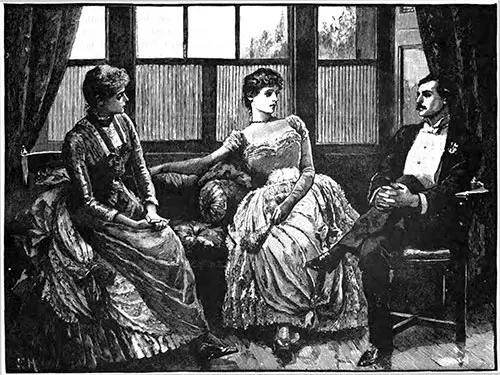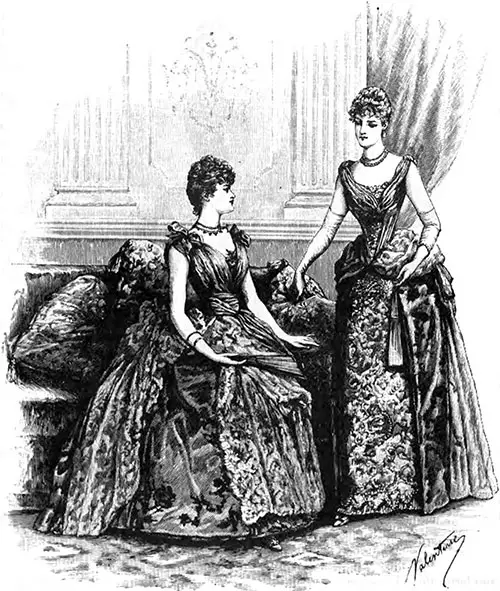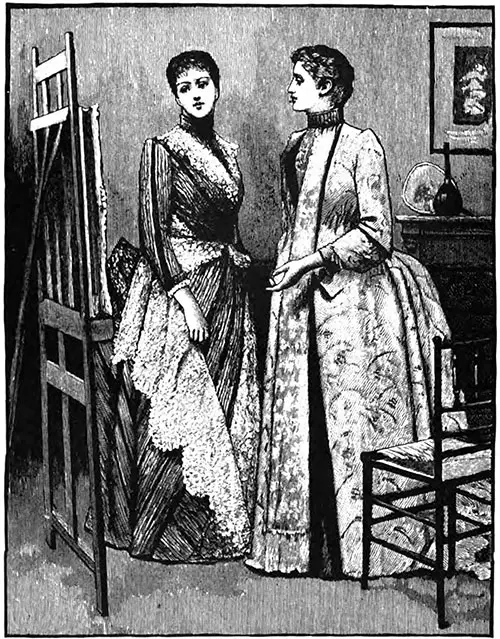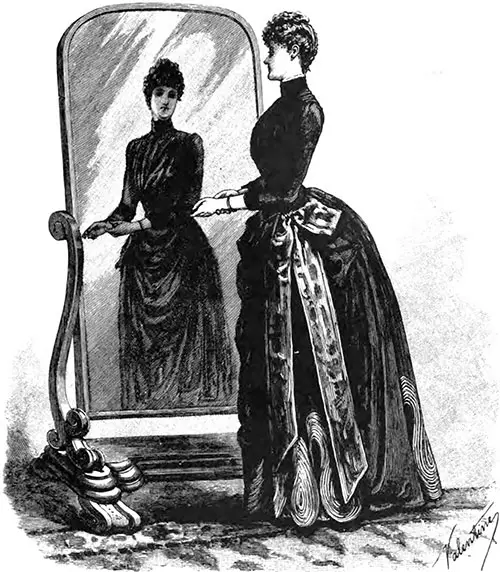London Fashions July 1888
By Mrs. Johnstone
Violette Johnstone takes on culture and fashion in analyzing the latest July women's fashion. From Evening Dresses and Gowns to Yachting Dresses, you will find a superb summary of the best designs.
Culture's Impact on Fashion
Culture has not always contributed to the economy of living. Whereas, before the era of railways, women were content to dress in the country in the same simple fashion as the rustics about them, now that traffic with the world has enabled them to see how others dress, they demand new gowns as good as the rest.
Though finery may be costly, a man does not care to see his womankind as less attractive than their neighbors. A writer who knew human nature well and had had opportunities of studying it in many lands, argued that this fact was a potent hindrance to the plurality of wives.
An extra wife who dressed well was an expensive luxury. Moreover, women who were arrayed like squaws, obeyed like squaws; but a love of finery armed women with the weakness of their sex —a most potent weapon. Moreover, this was a clever man's opinion and an excellent argument in favor of chiffons.
The dress is peculiarly an object of interest at present because so many varied styles are in fashion, and a well-dressed woman needs to bring knowledge and taste to bear upon it: knowledge of materials, of form, of color, and, above all, of what suits her own individuality.
Heavy brocades and rich materials are allowed to fall in straight lines or heavy folds so that the beauty of the stuff can be seen to the best advantage; but soft mousseline-de-laines, nun's veiling, Bengaline, and Oriental silks, are chosen for the grace with which they drape.
Evening Gowns

Evening Gowns designed by Messes. Dickins and Jones
The two accompanying dresses show how well Bengaline and Oriental silk can be adapted to ordinary evening gowns. The Bengaline is of the new steely grey shade, which is of the nature of an old-fashioned color called erewhile lavender.
It is intermixed with piece-lace, and a rich Pompadour silk with a shot gold and grey ground, having satin stripes of the two tones, between which brocaded floral bouquets appear.
The harmony of the Bengaline and the tint of the grounding are among the good points in this dress. The front drapery is entirely composed of the Bengaline, falling in loose folds. The back is half Bengaline, half Pompadour silk, slightly caught up at the waist, otherwise falling in straight lines.
A tasseled bow secures a panel drapery of the piece lace at one side. The bodice is made with silk draperies crossing over a lace waistcoat, with a ribbon bow in front. Pleats are laid on the back of the bodice.
The severe plain fronts are giving place to folds and gatherings of the material which very much soften the hardness of outline, but the sides of a bodice are now rarely alike. The collar bands are worn high, for a long throat is considered a beauty in a woman in these days.
The soft cream silk dress is delightfully cool for summer, and, with two bodices, can be made to answer the double purpose of dinner and day wear, being suitable for garden-parties and other dressy occasions.
The material wears and cleans well, and the more nearly it approaches to the creamy aspect of a thick soap lather, the more fashionable. Low bodices — in London, at all events—are worn at most evening parties during the season, and this one is simply made with a short sleeve and a broad sash.
It fastens at the back, and just a band of lappeting lace (such as having both edges waved) is laid around the top. In the present instance Valenciennes is employed to edge the draperies, and the wide flounces introduced on the skirt are visible at the sides.
The silk in front is caught up by a long loop of satin ribbon, starting from the waist. The back is almost straight; indeed, the arrangement generally can be accurately gleaned from the picture.

Evening Outfits, Designed by Mme. Eliza Nicole, New Bond Street
The Irish Lace Industry
Ireland is making great strides in her dress industries, and during the past months, there have been several displays in the metropolis of some of the newest specimens of her home-made lace.
Those on whom the designing falls have not only improved and extended old makes but have introduced new notions. For example, as the crochet reticella, modeled on the Greek patterns, and so fine, good, and moderate in price that it is being employed on many of the plain colored pongee silks and washing gowns, and is sufficiently durable to be handed down for generations.
Carrickmacross appliqué is better suited for evening gowns, so is the Limerick lace, the kind now made being fuller in a pattern than that hitherto used.
Trimmings and Edgings
Several new trimmings have been introduced of late, among the bands of leather four or five inches wide, laid around the skirt and carried up the front of woolen gowns; they are bordered with gold braid about an inch wide.
The suede kid in bold Renaissance designs, intermixed with filigree gold bullion, the groundwork all cut away, when laid on the material makes a very handsome trimming.
More splendid and showy are the coarse woven gold Russian braids, embroidered with Turkish letters in a variety of shades and tones of the same color, well combined on one piece of stuff.
All such trimmings are chosen with due regard to the shot and jardinière effects to be found in the stuff of the year, which are called "chameleon glace," and any other name that may occur to the fertile brain of the manufacturer, but they are always soft and lustrous in hue.
Accessorizing the Costume
Into the silks and metallic thread galons colored stones are introduced. "And thicker down the front with jewels than the sward with drops of dew, so thickly shone the gems," exactly describes the appearance of many of the embroidered breadths introduced into the fronts of gowns.
Some of the galons are worked on crepe lisse so that the color of the dress shows through and thus deepens the effect of the many tints with which they are wrought. Cream flannel in several widths is worked in the same manner, ready to be applied to both tennis and tea gowns.
Belts are always more worn with summer than with winter dresses, and some new kinds in leather show repousse designs like fish-scales or beautiful ivory carving.
Steel and oxidized chains around the waist confine the fullness of some makes of gowns. For example, a woolen of the blotting-paper tone, with wide stripes, the bodice and skirt all cut in one, the former made with a rounded yoke of shot silk to match the material, which is gathered over it in some six or seven lines, and again gathered in points at the back and front of the waist.
The skirt is hemmed round and allowed to fall over a plain petticoat, or it can be caught up to suit the wearer's figure. One of these chain belts over the waist-gathering is decidedly an addition. This style of dress is just one which could be applied to most of the requirements of life.
Without the yoke, it would serve for the evening, and it is sufficiently loose and unrestrained to answer the purpose of a tea-gown, which, by-the-by, was a garment originally intended to be worn without stays.

Gowns Sketched at Mme. Worth's, 134, New Bond Street
The idea of cutting all bodices on one plan has become long ago exploded. The clever disposition of stripes now makes an endless variety. We have illustrated one (above) of the newest adaptations. The gown is made in red and blue check and stripe combined.
The back of the skirt is on the cross, forming two wing-folds, carried out by sewing together the edges of one pleat; it is not gathered into the waist, but the jelly-bag point thus formed mingles with the drapery.
Two revers edged with lace are attached to the side diagonally, and so appear on the cross; the lace also forms the side basque, for the bodice is not only cut on the cross but folds one side over the other, showing a waistcoat of pleated silk, from which two pieces of lace turn outwards like a collar.
The sleeves are gathered into a wide cuff and are new in their arrangement. The silk is pleated here and there at the foot.
The tea gown displays some fine gold embroidery and multi-colored silk embroidery laid upon a velvet band, which appears on the left side and reappears at the waist. A gold bullion-tagged fringe is introduced on the sleeve and collar.
The gown is made of a cream Oriental silk, printed with a design of conventional grass in a tone which goes by many names: reseda, mousse d'eau (closely resembling the scum which rises on a marshy pool, and not so bright as pomme or the Sherwood green), etc.
The front is draped from the neck to the hem with figured piece-lace over the green. The silk sleeve ends at the elbow and is met by a puffing of the lace set in a velvet band at the wrist. The darker tone of the velvet gives a great deal of effect to the dress, especially by its introduction at the side.
It is made with a long train, and a pocket basque after the Louis XV order at the side. The trains are lengthening, and we are still in danger of the story repeating itself here, told of a certain French woman, who, while greeting her hostess, is reminded by the maître d'hotel that her gown is caught in the carriage door below.
We rarely have too much sun in England, but it comes in July if any month of the year. Nothing looks so well as white when Sol gleams through the trees in the country.
Hats, Bonnets, and Parasols
Those who keep their hats on all day are apt to find them heavy, and, in lieu of straw, "garden hats are now made of embroidery on muslin, some of the ordinary good well-covered designs, some of guipure, but all washable and light, in the picturesque shapes of the Rubens and Gainsborough order.
The drawn sun-bonnets now are made in pretty shapes too. A new tennis hat has this merit, that it is composed of a soft muslin which has been named "cloud," from its lightness, and that it can, by a touch of the hand, be turned up from the face during play, and be allowed to shade the face at other times.
A parasol made of a good strong serviceable lace has been arranged in the same light summer-like fashion to go with them.
The Latest in Gowns and Dresses
The reigning fashions favor tall and slender women, and the style of the gown with the front reflected in the looking-glass (see above) is one that would hardly be suited to a short woman. It commends itself by its simplicity.
It is a blue voile, the edge braided in large palm-leaves with white braid, a red moire ribbon tied at one side. The bodice has white bands introduced, and the fullness that crosses the figure is on one side plain, on the other side striped.
We are approaching rapidly to plain skirts, which possibly will be made without foundations. The full bodices, too, start with gatherings from the shoulder.

At Home Dress, designed by Mme. Eliza Nicole, New Bond Street.
Full dress increases in splendor as the months go by. Silver and gold brocades and embroidery of every kind play their part. A description of the two gowns in our picture will indicate the best English fashions.
The standing figure wears a pink crepe de Chine, mingled with pink Bengaline of a light tone. The front is worked with roses and other flowers in silk relief of the natural colors with pearls and gold thread.
There are paniers at the waist of the Bengaline, and the bodice is draped on one side with this, and on the other with the crepe, over a stomacher embroidered to match the front.
Nothing can well be more simple than the make of the dress, but the bodice fits to perfection. The other gown is of a rich red heliotrope tone, with a blonde scarf draped over the front and back, showing side panels with appliques of flowers in colors and gold leaves.
The bodice is trimmed to match with a wide Empire sash and large bows on the shoulders. Many gowns for evening wear are made with plain backs to the skirts, and over the front, a full breadth of silver or gold tulle, bordered with fringe, and allowed to droop as it will.
The bodice is draped over the shoulders, back and front, perpendicularly with the same tulle, and horizontally between; the front studded with diamonds down to the deep' sash.
The depth of this sash cannot be very easily defined. Sometimes they come well under the armpits and are shaped to the figure almost like a Swiss belt.
Yachting Dresses
The Directoire craze has extended to yachting-dresses, and cream flannel coats reaching to the hem are being made over petticoats, the front composed of close-set rows of broad braid, plain or intermixed with gold, a double pinked-out flounce at the edge of the skirt.
The coat fastens nowhere, but flies open, showing a full white silk bodice. It is a garment that would do admirably for the Cowes and Ryde week, but a heavy sea would soon spoil its beauty.
Johnstone, Violette, “July Fashions,” in The Woman’s World, Cassell & Company, Limited, London, Paris, New York & Melbourne, Volume I, No. 9, July 1888, p. 425-428.
Terminology
Carrickmacross lace is a form of lace that may be described as decorated net. A three-layer 'sandwich' is made consisting of the pattern (at the bottom), covered with, first, machine-made net and then fine muslin, through which the pattern can be seen. Carrickmacross lace was introduced into Ireland in about 1820 by Mrs. Grey Porter of Donaghmoyne, who taught it to local women so that they could earn some extra money. (Wikipedia)
Editor's Note: Some terminology used in the description of women's clothing during the 1800s and early 1900s has been changed to reflect more modern terms. For example, a women's "Toilette" -- a form of costume or outfit has an entirely different common meaning in the 21st century. Typical terms applied to "toilette" include outfit, ensemble, or costume, depending on context.
Note: We have edited this text to correct grammatical errors and improve word choice to clarify the article for today’s readers. Changes made are typically minor, and we often left passive text “as is.” Those who need to quote the article directly should verify any changes by reviewing the original material.

